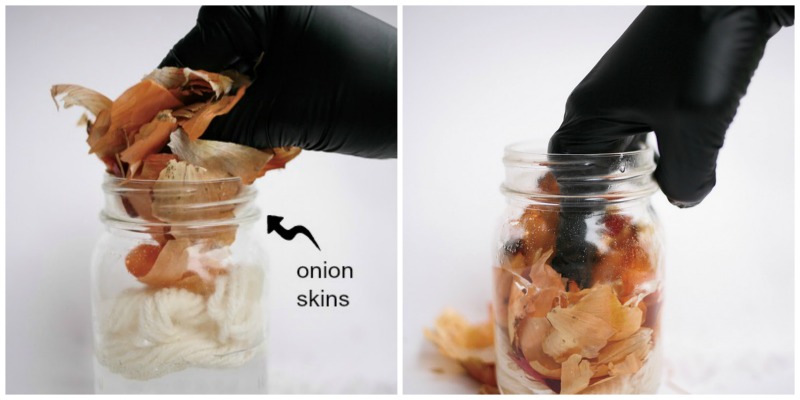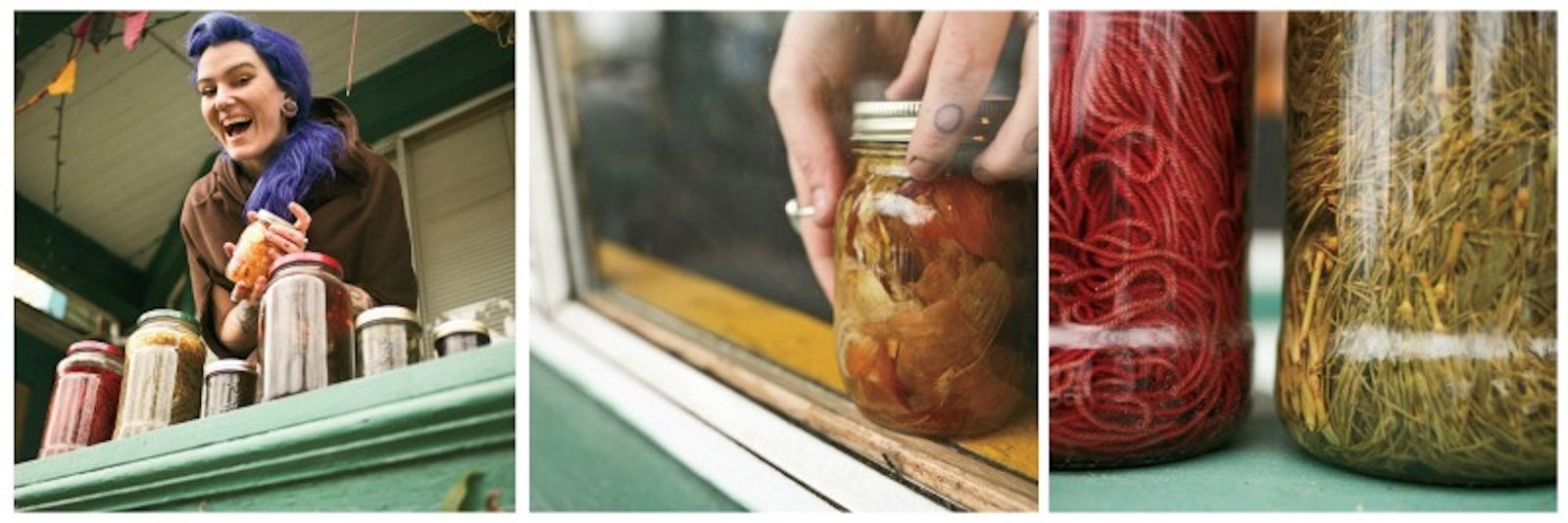Spend some time outdoors with beautiful colors and harness the power of the sun! Artist Caitlin ffrench explains how to dye yarn or fiber with natural materials and solar energy; hence, solar dyeing! Originally published in knitscene_ Summer 2013_
.
Solar dyeing is a natural method that requires very little work and results in non-repeatable, beautiful colors. It also requires very few tools, unlike stove-top dyeing and other dyeing techniques. In short, it’s an easy, natural, and fun way to give your yarn color and character.
Many amazing washfast dyes can be found in your supermarket and in your garden. A wealth of information is available in blogs, books, and online resources.
WHAT YOU’LL NEED FOR SOLAR DYEING:
- Jars with lids. You want both your dyes and your fibers to be able to float freely in a jar. Make sure that everything fits in the jar before you begin to assemble everything for solar dyeing.
- Mordants. Alum is a great mordant that gives good, clear colors. Other mordants can be used (for example iron, copper, and tin), but alum is the safest.
- Dyestuff. You can use freshly harvested plants, dyestuff that you may have found around your home, or natural dyes and dye extracts that you purchased online.
- Labels. Label your jars; you won’t remember later on what is in them.
- Nylons (optional). Put your dyestuff in a nylon stocking if the dyestuff might get stuck in your fiber (loose leaves for instance) and be hard to remove when rinsing.
- A sunny spot for your jar to sit. This can be indoors or outdoors. Be aware that the warmer your jar is, the quicker the dyes will adhere to the fibers.
- Natural fibers. You can dye spun and unspun fiber this way. Greasy wool or cotton that hasn’t been washed needs to be scoured clean with soap or a wool wash. Yarn needs to be in a skein to allow the dyes to strike all of the fibers.
- Teaspoon. I base my measurements for solar dyeing on 2–3 teaspoons of alum per 100 grams of fiber.
- Rubber gloves and a dust mask. Wear these when handling mordants and powdered dyes. Any time that you work with a fine powder or dust, you should be wearing a dust mask. The gloves will keep your hands clean.
- Ammonia or vinegar. These two liquids will alter the pH levels of the water and, in many cases, affect the final color of the fiber. Just a small amount is needed: no more than 1 or 2 teaspoons per 100 grams of fiber.

THE PROCESS
Pre-wet your fibers by placing them in a vessel of lukewarm water that covers them completely. Let them sit for 20–30 minutes. Doing this will allow both the mordants and natural dyes to strike the fibers evenly. If you prefer your fiber to have a more splotchy appearance, skip this step.

Step 1
Next, add warm water to the jar, about 1/3 full. Add your mordant (2–3 teaspoons per 100 grams of fiber), and let it dissolve in the warm water. Now add your dyes. If you are adding freshly harvested dyes or dyestuff that will get stuck in your fibers, put the dyestuff into a nylon and tie the end. The nylon will keep the dyestuff from becoming tangled in your fiber and causing a problem during rinsing. If you are using dye extracts, this step isn’t necessary. Add the ammonia or vinegar if you need to alter the pH levels of the water.

Step 2

Step 3

Step 4
Add your fibers to the jar. Consider layering more dyestuff on top of your fiber; having dyestuff on both the top and bottom will give you a more even distribution of color. To finish, add water until the jar is filled to the top. Allow the jar to settle, which may make the water level drop. If it does, top off the jar with water and allow the jar to settle again. Repeat this process of topping off until the water level remains full. Put the lid on your jar. It is now assembled!

Step 5
Now that your jar is ready, label it. As much as you would like to think you will remember what is in the jar, chances are that you will not in a few weeks/months. I know this from experience.
Place your jar in a sunny spot and leave it alone for a while. Your timeframe could be as little as a week or as long as a few seasons, depending on where you live and how sunny it is. You can turn your jar back and forth a few times a week if you wish for the fiber to have the color more evenly distributed, or you can leave the jar alone. When the water has become much clearer and the fibers have absorbed color, it is time to rinse your fiber!
To rinse your solar-dyed fibers, lift the fiber out of the jar (with gloved hands) and lay it in the sink. Wash it with a wool wash or soap, and rinse it until the water runs clear. Be mindful not to agitate the fibers too much; too much agitation may cause some fibers to felt. Hang your skein, untwisted, up to dry. Once it’s dry, wind a ball and enjoy your naturally dyed yarn!

Yarns shown above:
- (Pink) Briggs and Little Softspun Yarn; dyed with lac and madder; mordant: alum
- (Silky Yellow) Silk/wool blend; dyed with madder and fustic; mordant: alum
- (Purple Cotton) Universal Yarn Cotton Supreme; dyed with logwood/ quebracho; mordant: alum
- (Reddish brown ribbon) 100% silk ribbon; dyed with logwood/pomegranate; mordant: alum
—Caitlin ffrench
Featured Image: Author Caitlin ffrench shows off some of her handiwork at home in Vancouver, Canada. Photos by Sylvia McFadden. For more dyeing resources check out: Dyeing Yarn Free eBook: _Using Natural Dyeing Techniques._
Caitlin ffrench is a natural dyer and fiber artist in Vancouver, Canada. She is influenced by the surrounding land base of the Pacific Northwest and spends as much time as she can in the forest. wewilltellyouallofoursecrets.blogspot.ca Sylvia McFadden can be found online at flickr.com/photos/sylvia_mcfadden and softsweaterfibres.blogspot.ca
Sources for Supplies:
- Maiwa for exotic dyes and mordants: maiwa.com/
- Earthues for dyes and other materials: earthues.com

